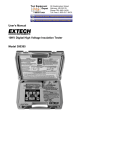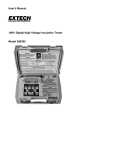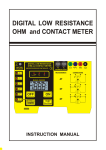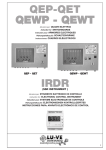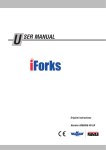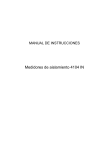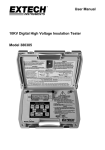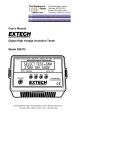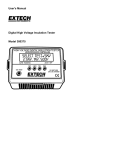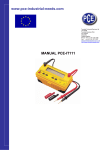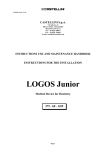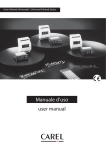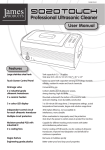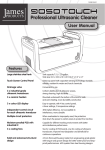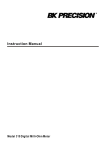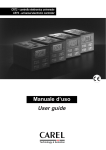Download 6213A IN(TIN7D) manual-2-°é»P¼Ú©i³æÂ঱½u
Transcript
TIN7D DIGITAL, VARIABLE, HIGH VOLTAGE, INSULATION TEST METER. TABLE OF CONTENTS Index................................................................................. Front Panel Layout.............................................................. Inside Lid Instructions.......................................................... Safety precautions............................................................... Overview............................................................................ Features............................................................................. Connections........................................................................ Specifications...................................................................... Functions............................................................................ Special Features.................................................................. Preparation for Measurement............................................... Maintenance and Cleaning Method..................................... Insulation Resistance Testing................................................ Typical Applications of Insulation Testing............................... Limited warranty................................................................. -2- 2 3 4 5-8 9 10 11 12 13-15 16-17 18 19 20 21-23 24 P16 2 AUTO-RANGING -3- INSULATOR TM TM TEST START / STOP With EnerSave ON 1KV + 500V 2.5KV VOLTAGE ADJUST 5KV 8 4 5 3 7 6 1 EnerSave is the default mode. EnerSave limits the test duration. AUTO-OFF TM To disable EnerSave , depress "TEST" for more than 3 Sec while TM starting a new test. The Short Beep while depressing mean EnerSave is OFF TM OFF 500V 10KV MICROPROCESSOR CONTROLLED MODEL TIN7D FOR DAR and PI TESTS, ALWAYS DEPRESS TEST FOR MORE THAN 3 SEC. EARTH GUARD INSULATION LINE EARTH OUTER SHEATING COVERING Note: LINE In some cases, Readings on NON PURE RESISTIVE Loads may be Unstable. +HV SAFETY PRECAUTION! LINE CABLE CORE GUARD INSULATION +HV terminal SEE PAGES 13 to 17 FOR EXPLANATIONS ALWAYS READ USER'S MANUAL BEFORE OPERATING THIS INSTRUMENT. – Use only on de-energised and isolated / disconnected system. DO NOT PROCEED IF VOLTAGE PRESENT !!! – Check test leads for defects. If any cracks or damages, replace with new test leads of Same specifications. – Always earth circuit under test. – After testing, allow a few seconds for instrument to discharge circuit under Test. Follow discharge on the display. OPERATING INSTRUCTIONS 1. Depress "ON" . 2. Insert leads into the instrument observing color coding. 3. Clip GREEN lead to earth . Connect Guard to collect surface leakage current. 4. Select test voltage and follow display instructions. CAUTION 5. Touch RED lead to other side of circuit under test . Stop test immediately if warning message and/or buzzer sounds. This indicates the presence of an external voltage which must be removed. Before proceeding again, reset the tester by depressing "ON" 6. Connect RED lead to other side of circuit under test and Depress "TEST" to start and stop the test (tests up to 10 minutes when EnerSave TM is off). 7. Display shows test duration, real time bargraph voltage indication and Insulation Resistance, after 1 Min, the DAR and after 10 Minutes, the PI. DAR PI GUARD GUARD terminal AUTO-OFF 10kV VARIABLE DIGITAL INSULATION TESTER L.C.D. AUTOMATIC POLARISATION INDEX AND DIELECTRIC ABSORPTION RATIO EARTH -HV -HV terminal 0. FRONT PANEL LAYOUT and INSIDE LID INSTRUCTIONS. FRONT PANEL LAYOUT -4- SAFETY ! – The circuit under test must be de-energized AND isolated before insulation test are made. – Check Test Leads for Defects, they must have good, unbroken insulation, uncontaminated by grease, oil or dirt. – For optimal results, only use supplied Test Leads. – To avoid creating leakage path when insulation testing, it is advisable not to allow the leads to twist together nor trail accross metalwork etc., more than is really necessary. If this can't be avoided, only the Optional, Proprietary, Very High Voltage, Coaxial Silicone Test Lead could give best results. – Make sure to Earth Circuit under Test. – Wait until display shows "HOLD" before removing the test Leads. CAUTION ! – Instrument used in dusty environment should be send only, to an approved maintenance laboratory for periodic cleaning.– The instrument contains static sensitive devices. If opened for any reason, the warranty will be invalidated. ENERSAVE MODE – saves battery life by Automatically turning The Instrument to Low Consumption and reducing the test duration. – is the default mode of the Instrument. – is enabled when pressing the "TEST" button for less than 3 seconds while starting the test. – is disabled when pressing the "TEST" button for more than 3 seconds while starting the test (user to disable for PI and DAR tests). When The ENERSAVE Mode is disabled, the Instrument Operates Continuously (up to 99.9s).Testing can be interrupted at any time by depressing Test Start/Stop key. Discharge Always Applied automatically. WARNING ! This instrument should not be used in explosive or inflammable environments, although there is unlikely to be a fire hazard from the instrument itself. However, arcing in faulty insulation, sparking caused when making or removing connections to equipment that has not been properly deenergized, or discharge of capacitance following tests, can all lead to explosion or fire hazard. Insulation Tester Specified with Alkaline Batteries. EARTH GUARD LEAKAGE LINE INSULATOR TYPICAL TEST Preventive Maintenance : when the results are entered into the logbook, a considerable variation between the tests could be noted. It is therefore important to test under similar conditions each time and to note the current weather status. Damp conditions can cause large reductions in insulation resistance. Temperature of the equipment under test should also be noted. FOR DAR and PI TESTS, ALWAYS DEPRESS TEST FOR MORE THAN 3 SEC. PI =POLARIZATION INDEX DAR = DIELECTRIC ABSORPTION RATIO RESISTANCE MEASURED AT 1 MINUTE RESISTANCE MEASURED AT 30 SECONDS RESISTANCE MEASURED AT 10 MINUTES PI= RESISTANCE MEASURED AT 1 MINUTE DAR= USE THE GUARD ! This Instrument has an Integral Guard Circuitry to Minimise the measurement errors introduced by surface leakage current. During insulator testing, for example; a leakage path may exist between the connection to the line conductor and the connection to the earth conductor due to dirt or moisture contamination. Where this possibility exist, particularly when testing at higher voltages, a bare conductor may be bound tightly around the insulator and connected to the guard terminal as shown. The guard test lead is provided with alligator for this purpose. The leakage current is then going into the guard connection instead of having it's path in parallel with the measurement. Without the Guard, Insulation resistance appears lower than with the Guard. INSIDE LID INSTRUCTIONS. 1. SAFETY PRECAUTIONS. SAFETY RULES CAUTION RISK OF ELECTRIC SHOCK This tester has been designed with your safety in mind. However, no design can completely protect against incorrect use. Electrical circuits can be dangerous and/or lethal when lack of caution and/or poor safety practices are used. Do not carry out field measurements on either the power system grounding, during periods of forecast lightning activity, or any non insulated system or non insulated circuit. In the event that lightning occurs, stop all testing and isolate and remove any temporarily installed test spikes or test leads. Preparations for testing of power system grounding or close to it can leave personnel vulnerable to exposure caused by faults at or fed from the system under test, transferred potentials from remote test grounds, and inadvertent line energizations. Always insulate the device under test. While the probability of the occurrence of one of these events is low, personnel safety will, nevertheless, be enhanced by the following: When working near high tension systems rubber gloves and shoes should be worn. Work on clean, dry crushed rock or an insulating blanket. Avoid bare hand to hand contact between the tester and extended test leads. When using the tester with test leads, ensure that they are safe and properly authorized Disconnect the tester from any external circuit when checking or changing the Fuse and/or batteries. CAUTION READ THE MANUAL Follow the instructions in the Manual for every measurement. Read and understand the general instructions before attempting to use this tester -5- SAFETY CHECK Before using the tester check the condition of the test leads and the fuses. If using fused test leads. The test leads must be free of cracks or any damages and must be insulated as when they were new. Always disconnect the test leads when changing the batteries by removing the cover which give access to the batteries. Always double check the lead connections before making any measurements. For increased safety, use fused test leads (optional). DON'T TOUCH Don't touch exposed wiring, connections or other "Live" parts of an electrical circuit. If in doubt, check the circuit first for voltage before touching it. Do not use cracked of broken test leads. THIS INSTRUMENT SHOULD ONLY BE USED BY A COMPETENT, SUITABLY TRAINED PERSON. REMEMBER SAFETY IS NO ACCIDENT CAUTION RISK OF ELECTRIC SHOCK CAUTION READ THE MANUAL -6- Electricity can cause severe injuries even with low voltages or currents. Therefore it is extremely important that you read the following information before using your Variable High Voltage Digital Insulation Meter. 1.1 This instrument must only be used and operated by a competent trained person and in strict accordance with the instructions and safety practices. We will not accept liability for any damage or injury caused by misuse or non compliance with instructions and safety procedures. 1.2 This instrument must not be used on live circuits. Ensure all circuits are de-energized before testing. See paragraph 1.7 for details of builtin warning features should your Variable High Voltage Digital Insulation Meter be connected to a live system. 1.3 Never open your Variable High Voltage Digital Insulation Meter except for battery replacement. (See Battery Replacement section). 1.4 Always inspect your Variable High Voltage Digital Insulation Meter and test leads before using for any sign of abnormality or damage. If any abnormal conditions exist (broken test leads, cracked case, display faulty etc...) do not attempt to take any measurement or use the tester. Return your Variable High Voltage Digital Insulation Meter to your nearest distributor for service. 1.5 Your Variable High Voltage Digital Insulation Meter has been designed with your safety in mind. However, no design can completely protect against incorrect use. Electrical circuits can be dangerous and/or lethal when a lack of caution or poor safety practice is used. Use caution in the presence of voltage above 24V as these pose a shock hazard. 1.6 Pay attention to cautions and warnings which will inform you of potentially dangerous procedures. -7- 1.7 Your Variable High Voltage Digital Insulation Meter has a live circuit warning beeper. If It is connected to a live circuit, a rapid pulsating bleep will be heard. DO NOT proceed to test and immediately disconnect the instrument from the circuit. In addition your tester will display the warning message. -8- 2. OVERVIEW. This digital insulation tester is a variable high voltage insulation meter from 500 V to 10KV in 500V steps. Its output voltage can be adjusted using 500 V up or down steps. The meter is menu driven and uses Dynamic Current Auto-ranging technology. It is equipped with a bar-graph which displays the voltage stressing the insulation while the test is in progress. This bar-graph is showing voltage output during the first 30 seconds of the test or during automatic discharge of circuits. During the automatic discharge of the circuit tested, the bar-graph displays the voltage decay. The display shows the elapsed time since the start of the test. Digital readout of the total time remains displayed even after testing has ceased. A 6 digit digital display is showing the actual Insulation Resistance. This instrument displays and sounds a voltage warning when AC or DC is present before injecting the test voltage. The warning circuit can only detect when voltage is higher than 500V . This Variable High Voltage Digital Insulation Meter will buzz intermittently when high voltage is generated and this will remain until the circuit under test is fully discharged. -9- 3. FEATURES. 2 x 16 characters, large, High Contrast, Intelligent L.C.D. Module. 20 Insulation test voltages 500V, 1KV, 1.5KV, 2KV, 2.5KV, 3KV, 3.5KV, 4KV, 4,5KV, 5KV, 5.5KV, 6KV, 6.5KV, 7KV, 7.5KV, 8KV, 8.5KV, 9KV, 9.5KV, 10KV. Calculate Dielectric Absorption Ratio (DAR) Automatically. Calculate Polarization Index (PI) Automatically. Insulation resistance Auto-Ranging on all ranges. TM Ener-Save . Bar graph indicates test voltage. Rise and decay can be observed. Warning of external voltage presence(>500Vac or Vdc). Overload protection. Low battery indicator (real time battery Voltage Measurement). Measure insulation time duration of the test. Low battery consumption. Smart microprocessor controlled. One year factory warranty. Better than 10% accuracy on all ranges. Auto-off. Compact and lightweight. -10- 4. CONNECTIONS. INSULATOR -HV 10kV VARIABLE DIGITAL INSULATION TESTER EARTH GUARD -11- +HV LINE 5. SPECIFICATIONS. Test Voltage From 500Vdc to 10KVdc Adjustable in 500 V Steps Preset Buttons 1KV, 2.5KV, 5KV, 10KV Measuring Range 800K -500G AUTO-RANGING Accuracy ± 5% ± 2 digits Power 8 x 1.5V Alkaline batteries Output Power Limit 1W Voltage Regulation Selected Voltage +20%-5% of nominal value unless current limited. Meaning that if output current is too high, the voltage will be lowered automatically. Accessories Color coded flexible silicone test leads and instruction manual. Special Standard Accessory on this model Anti-leakage, Color coded, Flexible silicone coaxial test lead with integrated guard, into the test probe. -12- 6. FUNCTIONS (see FRONT PANEL LAYOUT). 6.1 Power-On To switch your instrument on, press the "ON" button ( 1 ). The L.C.D. will display the model number. Follow interactive instructions on L.C.D.. 6.2 Insulation Resistance Measurement @ 10kVdc. To Select 10KVdc test voltage, press 10KV button ( 2 ). 6.3 Insulation Resistance Measurement @ 5KVdc. To Select 5KVdc test voltage, press 5KV button ( 4 ). 6.4 Insulation Resistance Measurement @ 2.5KVdc. To Select 2.5KVdc test voltage, press 2.5KV button ( 5 ). 6.5 Insulation Resistance Measurement @ 1KVdc. To Select 1KVdc test voltage, press 1KV button ( 6 ). Insulation Resistance Measurement @ Multiple of 500Vdc adjustment To add 500Vdc to the selected test voltage, press +500V button ( 7 ). To subtract 500Vdc to the selected test voltage, press -500V button ( 8 ). 6.6 6.7 Ener-SaveTM mode. The Ener-Save TM mode saves battery life by automatically turning the instrument to low consumption (reducing the test duration ). The Ener-Save TM mode is the default mode of the instrument. The Ener-Save TM mode is enabled when pressing the TEST button ( 3 ) for less than 3 Seconds . The Ener-Save TM mode is disabled when pressing the TEST button ( 3 ) for more than 3 seconds. When Ener-Save TM mode is disabled, the instrument operates in continuous mode (up to 10 minutes) . 6.8 Voltage Output Bar-Graph. The bar-graph shows the voltage present on the leads. It also shows the voltage charging a cable or capacitive system under test and shows the decay during the automatic capacitive discharge of the system under test. -13- 6.9 Auto-Low Resistance Detect. While in insulation test mode, if the L.C.D. Module shows "LOW M ", stops the test immediately. This could mean that the insulation has a breakdown, thus, you are now trying to inject very high voltage on a short circuit. Trying to inject high voltage on a short circuit could reset the instrument (specially if flashing Occurs). 6.10 Timer. The duration of the test is shown on the top right of the L.C.D. This is particularly useful to verify that insulation does not break down within a certain time or to make comparison. See Special Features for more Timer Functions. 6.11 STOP test. To stop the test in progress, press the TEST button ( 3 ). The test will immediately stop, discharge and the instrument will reenable the Ener-Save TM mode automatically. 6.12 Auto-Stop. Should the operator leaves the Instrument in the test mode with the Ener-Save TM disabled, theinstrument will automatically stop the test after a duration of 10 minutes.( Auto-off still applies ). 6.13 Auto Live / Voltage Warning. Should the leads be placed onto a live system before starting the test, a warning beeper will be automatically activated and your instrument will display " Live Warning ... Circuit Live .. " message. Let the instrument discharge the circuit ( in the case of capacitive system) or make sure that the circuit under testing is not live . 6.14. Auto - Discharge. At auto-stop or test completion, the instrument automatically discharges the system under insulation test so that the dangerous high voltage is discharged. The auto-discharge can be observed on the L.C.D.'s bar graph so that the operator only removes the leads when the discharge is complete. -14- During discharge, a beep occurs so that the user does wait for the complete discharge of the system under test. This is indicated by a one second long beep accompanied by the "HOLD" message on the display. DO NOT REMOVE LEADS UNTIL THE HOLD MESSAGE APPEARS ON THE DISPLAY. 6.15 "Replace Battery" Warning Indicator. If the battery energy is detected to be too low, the instrument will display the "Battery" warning. The instrument cannot operate properly with a low battery. 6.16 Auto-Off. The Auto-off is annunciated by a one second beep. The Autooff timer is automatically enabled. The instrument can also be switched off by pressing and holding the OFF key for more than 5 seconds. -15- 7. SPECIAL FEATURES. 7.1 DAR = Dielectric Absorption Ratio. The dielectric Absorption Ratio is the ratio of the Insulation Resistance measured at 1 Min divided per the Insulation Resistance measured at 30 Seconds. 30 Seconds after starting a test (with EnerSave disabled), the tester will beep, indicating the operator that the resistance value measured at 30 second now has been saved internally. 1 Minute after starting a test (with EnerSave disabled), the tester will beep again, indicating the user that the DAR result is now computed, and change the display format to now display the DAR result. 7.2 PI = Polarization Index. The Polarization Index or PI is the ratio of the Insulation Resistance measured at 10 Minutes divided per the Insulation Resistance measured at 1 Minute. 10 Minutes after starting a test (with EnerSave disabled), the tester will beep again, indicating the user that the PI result is now computed, and change the display format to now display the PI result. The tester will Auto-Stop at 10 minutes. 7.3 Digital Display. The digital Liquid Crystal Display is large. It measures (W)98mm x (H)24mm and has a 2 Lines of 16 Characters. Language can be changed on demand, as an option. Dutch / French / German etc... (factory fitted at order) 7.4 Automatic Battery Test. When the tester starts, it test it's batteries by drawing a heavy current from the batteries. During that heavy current, it measures the battery voltage and displays it for a few seconds on the display. During normal use, the tester monitors the battery voltage, but without drawing a battery test current. It just measures the battery while in normal use. -16- 7.5 Automatic Discharge of Capacitive and Inductive Circuits This tester will discharge automatically all circuits charged by the tester, after a test is done, again, this will only be activated if the test leads make contact at any time before, during and after the test. It's your responsibility to ensure proper contact of the leads at all times. Once a test is finished, the testers will automatically discharge capacitive or inductive circuit of their charge. The discharge can be observed on the display, in the form of a bar-graph. Again, do not disconnect the leads while discharging. Wait until completion of the discharge before removing any lead. During discharge, the Buzzer will beep and the bar-graph will show some voltage. With some high charges, this may take some time. Be patient and let the instrument discharge completely before proceeding to removing the leads. -17- 8. PREPARATION FOR MEASUREMENT 8.1 Before testing, always check the following: At Power "ON", read the display to make sure the " Replace Battery" message is not displayed. Verify that there are no visual damage to the instrument or test leads. Test Leads continuity: Using a Ohm-meter, check the resistance/continuity of the leads. -18- 9. MAINTENANCE AND CLEANING METHOD. 9.1 Battery Replacement. Your insulation tester's battery is situated under the tester. The display will indicate when battery needs to be replaced. Disconnect the test leads from the instrument and removes the battery cover and the batteries. Replace with eight ALKALINE 1.5V "C"size, taking care to observe correct polarity. Replace battery cover. 9.2 Cleaning & Storage. Periodically wipe the case with a damp cloth and detergent. Do not use abrasives or solvents. If the meter is not to be used for long periods or longer than 60 days, remove the batteries and store them separately. Warning To avoid electrical shock or damage to the meter, do not get water inside the case. Store the meter in a dry environment. 9.3 Calibration & Servicing Both, calibration and servicing are performed only at an approved facility. Contact your nearest distributor about calibration certificate and servicing . Before returning the instrument, ensure that : the leads have been checked for continuity and signs of damage. the batteries are in good condition. -19- 10. Insulation Resistance Testing . Warning : Insulation test should be conducted on circuits that are de-energized. Ensure circuits are not live before commencing testing. – Secure both test leads properly to the insulation to test and use guard lead to collect surface leakage. – Good contacts are necessary to avoid flashing at high voltage or ionization or creation of carbon track type conductive material. – If contacts are not properly secured, the tester may be corrupted temporarily by the high electromagnetic field present. Should this occur, let it reset itself. – Use only battery ( Alkaline ) to power this instrument . DO NOT USE ANY KIND OF ADAPTER OR CONNECTION TO THE MAINS POWER. -20- MEASURING AN INSULATOR When measuring insulator, there are a few things to consider: 1- Most insulators collect dust and get contaminated over time with a mixture of Moisture, rain, dirt etc... 2- These matters lower the resistance of the insulator as they are in parallel with the insulator resistance. 3- It is recommended to measure the insulator first without the guard to verify that the total resistance is high. Should the total resistance not be high, that could mean that the amount of dirt on the surface of the insulator is too high and therefore, the insulator may require cleaning. 4- Should your insulator require cleaning, follow the procedures recommended by it's manufacturer. 5- For Final Test and Measurement, use the Guard so that leakage surface current is collected and Insulator is intrinsically tested. The insulator must not be connected to any live component or power source. Use a tied copper wire around the insulator at about its center to connect the guard. FIRST MEASUREMENT MEASURE WITHOUT THE GUARD TO TAKE EVERYTHING INTO ACCOUNT AND FIND OUT IF NEED CLEANING. DIRTY INSULATOR LINE ELECTRICAL EQUIVALENT CIRCUIT DIRTY INSULATOR LINE TYPICAL TEST LINE LEAKAGE RESISTANCE DUE TO CONTAMINATION INSULATOR INSULATOR RESISTANCE LEAKAGE DUE TO CONTAMINATION EARTH SECOND MEASUREMENT MEASURE WITH THE GUARD TO ENSURE INSULATOR IS CORRECT. EARTH GUARD INSULATOR EARTH RESISTANCE DUE TO CONTAMINATION CAN BE VERY LOW AND LOWER THE TOTAL RESISTANCE. CLEANING PERIODICALLY CNA ALSO REDUCE SYSTEM POWER CONSUMPTION. -21- MEASURING THE INSULATION OF A CONTACTOR OR CIRCUIT BREAKER Contactor or Circuit breaker are switching devises which when closed, must do a good contact (have the lowest resistance possible) and when open, must be a good insulator (have the highest resistance possible). As they get older, their characteristics may deteriorate due to many factors. Their material properties may deteriorate with time and frequency use as well as stress put on to them. One of the factor we will be testing is their insulation when acting as an open circuit. Contactors or circuit breakers may also get dirty as they are utilized in heavy duty environments, like factories, mines etc.., Which have climatic conditions which are harch. When they are dirty, their insulation may deteriorate due to the deposit of matters between the terminals (see previous page about parasitic resistance due to dirt contamination). The Contactor or Circuit Breaker must not be connected to any live component or power source during its testing. -22- MEASURING INSULATING PAINT or INSULATING MATERIAL In many applications, paint is utilized as an important insulating material. For example, transformers are painted or dipped with insulating varnish, large power transformers are painted with High Voltage insulating paint of very high specifications. Many Applications uses insulating material to protect personal and equipments. For example insulating blankets, insulating suits, insulating gloves, etc... These material can be quickly checked to general purpose, in day to day use, or before sending for further more in deep tests. Testing these can be tricky and require proper test jigs, so we will just explain the principle of their testing for general knowledge. -23- LIMITED WARRANTY We warrant the product manufactured by us to be free from defective material or factory workmanship and agree to repair or replace this product which, under normal use and service, disclose the defect to be the fault of our manufacturing, with no charge for parts and service. If we are unable to repair or replace this product, we will make a full refund of the purchase price. Consult the user's manual for proper instruction regarding use of this instrument. Our obligation under this warranty is limited to repairing, replacing or making refund of this test equipment which proves to be defective within twelve months from the date of original purchase. This warranty does not apply to any of our products which have been repaired or altered by unauthorized persons in any way so as, in our sole judgement, to injure their stability or reliability, or which have been subject to misuse, abuse, misapplication, negligence or accident or which have had the serial numbers altered, defaced or removed. Accessories, not of our manufacture used with this product, are not covered by this warranty. All warranties implied by law are hereby limited to a period of twenty four months, and the provisions of the warranty are expressly in lieu of any other warranties expressed or implied. The purchaser agrees to assume all liability for any damages or bodily injury which may result from the use or misuse of the product by the purchaser, or its user, his employees, or others, and the remedies provided for in this warranty are expressly in lieu of any other liability we may have including incidental or consequential damages. We reserve the right to discontinue models at any time, or change specification, price or design, without notice and without incurring any obligation. -24-
























